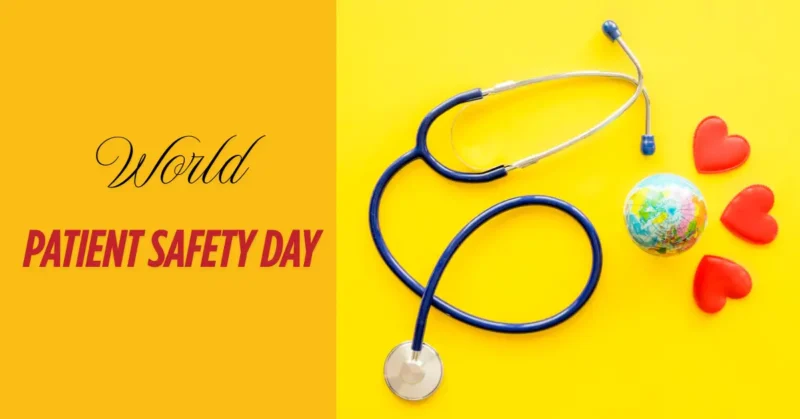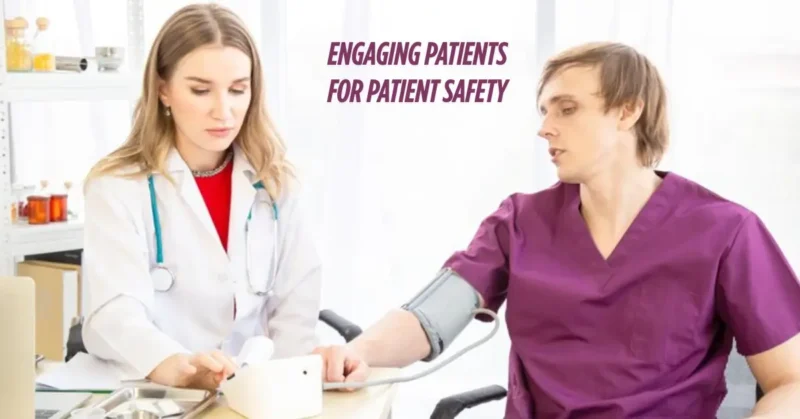Celebrate World Patient Safety Day by learning how to elevate patients’ voices for safer care. Explore strategies to empower patients, improve healthcare outcomes, and promote a culture of safety.
Thank you for reading this post, don't forget to subscribe!How to Elevate the Voice of Patients for Safer Care
On World Patient Safety Day, we come together to shed light on an issue of utmost importance—patient safety. This global initiative aims to raise awareness, drive discussions, and ignite action toward safer healthcare practices.
In this comprehensive blog post, we’ll delve into the significance of World Patient Safety Day, explore why patient safety matters, and uncover ways patients and their families can actively participate in this vital cause. Let’s embark on a journey toward a safer healthcare world.
Safety is paramount in healthcare. Everyone deserves the assurance of receiving quality, secure medical attention. This belief forms the foundation of World Patient Safety Day, an annual event celebrated worldwide to highlight the importance of patient safety.

This comprehensive blog post explains World Patient Safety Day, why it’s essential, and how you can actively participate to ensure safer care for all.
What is World Patient Safety Day?
The World Health Organization (WHO) started the annual September 17th global healthcare celebration known as World Patient Safety Day. It aims to enhance understanding of the importance of patient safety and promote practices that reduce preventable harm in medical environments.
The day highlights the importance of collaboration among healthcare providers, patients, their families, and legislators to communicate more effectively and create safer systems. It highlights that all individuals, including physicians, nurses, patients, caregivers, and leaders, have a responsibility to guarantee that care is provided in a safe, efficient, and courteous manner.

Every year, World Patient Safety Day focuses on a subject that addresses a significant issue, such as patient involvement, diagnostic safety, or safeguarding vulnerable populations, including infants and children. These topics highlight areas where advancements can save lives, alleviate suffering, and foster confidence in healthcare systems on a global scale.
Official activities include educational campaigns, policy discussions, public outreach, and symbolic gestures, such as lighting landmarks in orange, the official color of the day. These global efforts aim to drive change from the grassroots level to the highest levels of decision-making in health.
The ultimate goal of World Patient Safety Day is to promote a culture in which patients are active participants in their treatment rather than passive recipients, where safety is given top priority, and where healthcare errors are openly acknowledged and rectified.
World Patient Safety Day 2023–2025
2023: Engaging Patients for Patient Safety

On 17 September 2023, the WHO championed the pivotal role of patients, families, and caregivers in ensuring safety with the theme “Engaging Patients for Patient Safety” and the rallying slogan “Elevate the voice of patients!”. Empirical evidence underscores that empowering patients as partners leads to greater safety, satisfaction, and health outcomes. WHO called for the inclusive representation of patients in governance, policy design, and care processes, embedding these principles in the Global Patient Safety Action Plan 2021–2030 and Resolution WHA72.6.
Key Objectives:
- Advocate for family-centered safety aligned with global action frameworks.
- Increase awareness of patient and caregiver engagement.
- Drive stakeholder involvement—from policy-makers to civil society.
- Enable proactive patient participation in personal care and system improvements.
2024 – Improving Diagnosis for Patient Safety
Marking the 2024 observance (17 September), WHO focused on diagnostic accuracy under “Improving Diagnosis for Patient Safety,” wrapped with the slogan “Get it right, make it safe!”. Diagnostic errors—missed, delayed, or incorrect—account for around 16% of preventable patient harm. Addressing this requires clarity in patient-physician communication, robust systems, and active involvement from the family.
Critical Components:
- Promoting global unity through seminar events, landmark illuminations, and stakeholder mobilization.
- Deconstructing the diagnostic journey: from history-taking to follow‑up.
- Tackling systemic and cognitive contributors to diagnostic errors.
2025 – Safe Care for Every Newborn and Every Child

The 17 September 2025 theme spotlights vulnerable populations: “Safe care for every newborn and every child,” with a compassionate slogan: “Patient safety from the start!”. Statistically, children—especially neonates in intensive care—face higher rates of adverse events. The aim is to align pediatric safety with SDG targets and global initiatives such as the “Every Woman, Every Newborn, Everywhere Action Plan.”
Strategic Pillars:
- Advocate for the safety of newborns and children in all care settings.
- Mobilize multisector collaboration for sustainable pediatric safety measures.
- Educate and empower caregivers and children in first-line safety.
- Foster targeted research in pediatric and neonatal safety protocols.
Evolution in Focus: 2023 → 2025
These themes signal a progression from individual engagement to clinical accuracy, culminating in specialized protection for children. Each theme builds upon prior ones, shaping a comprehensive agenda that covers participation, diagnostic excellence, and vulnerable demographics.
In‑Depth Insights and Strategic Imperatives
1. Engaging Patients: The Cornerstone of Safety
Turning passive recipients into active partners revolutionizes health outcomes. Evidence from AHRQ suggests that early interruptions in patient stories contribute to approximately 79% of diagnostic errors. “Elevating the voice” means systematically including patient perspectives at every level—from bedside communication to health policy design.
2. Diagnostic Safety: Breaking the Chain of Errors
Diagnostic errors remain a primary source of medical mishaps. In the U.S. alone, diagnostic missteps permanently incapacitate or kill hundreds of thousands annually. The 2024 theme encourages healthcare systems to adopt tools like MeasureDx and TeamSTEPPS, bolster clinician training, and deepen patient involvement in diagnostic reasoning.
3. Safe Newborn & Child Care: A Critical Need
Newborns and young children endure disproportionate risks in medical settings. The 2025 campaign underscores comprehensive safety, from childbirth to immunizations, through global coordination, caregiver empowerment, and focused research. It reaffirms every child’s right to safe healthcare from day one.
Action Plan: Implementing the Themes
A. For Healthcare Leaders
- Policies: Integrate patient and family voices in boards and protocols; institutionalize diagnostic safety measures.
- Training: Workforce programs targeting communication, diagnostics, and pediatric safety.
- Infrastructure: Safety checklists and safety reporting systems tailored to different settings.
B. For Clinicians & Care Teams
- Engage: Allow patients to fully express concerns; involve family in care planning.
- Diagnose: Follow structured diagnostic pathways; use peer review and multidisciplinary input.
- Protect Children: Adapt safety protocols to age-specific needs, especially in pediatric units.
C. For Patients & Caregivers
- Self‑advocacy: Be vocal and informed; ask questions and participate.
- Education: Learn critical safety measures—especially those related to newborn care, medications, and follow-up procedures.
D. For Policy-makers & Funders
- Invest: Fund applied research on diagnostic and pediatric safety.
- Regulate: Mandate patient engagement and diagnostic oversight in healthcare institutions.
- Monitor: Set national benchmarks for pediatric adverse events and diagnostic accuracy.
Activities and Events to Celebrate World Patient Safety Day

World Patient Safety Day is celebrated globally through various activities and events:
- Webinars and Workshops: Healthcare organizations, government agencies, and NGOs often host webinars and workshops to educate healthcare professionals and the general public about patient safety.
- Public Awareness Campaigns: Hospitals and healthcare facilities may launch campaigns to inform patients about their rights and responsibilities in ensuring their safety.
- Patient Stories: Patients and their families often share their stories of navigating the healthcare system, highlighting successes and challenges in advocating for their safety.
Resources for Patients and Their Families to Learn More about Patient Safety
Here are some valuable resources to help patients and their families learn more about patient safety:
- WHO Patient Safety: Online resources and tools from the World Health Organization to promote patient safety worldwide.
- Patient Safety Network: A comprehensive resource by the Agency for Healthcare Research and Quality (AHRQ) providing information on patient safety initiatives.
- Patient Advocacy Organizations: Organizations like Patient Safety Movement Foundation and Patients for Patient Safety offer support, resources, and advocacy opportunities.
FAQs | World Patient Safety Day
Q. How can you promote patient safety?
Promoting patient safety begins with creating a culture of openness, respect, and accountability within healthcare settings. Healthcare professionals should follow evidence-based practices, communicate clearly with patients, and use safety checklists to reduce errors.
Encouraging teamwork, continuous learning, and reporting of mistakes without blame is essential. Patients should be educated about their conditions and encouraged to ask questions. Regular training and simulations can also help staff prepare for emergencies. Involving families in care decisions improves awareness and monitoring. Consistent evaluation and improvement of systems ensure safer outcomes for everyone.
Q. What is the theme of World Patient Safety Day 2023?
The theme for World Patient Safety Day 2023 is “Empowering Patients for Safer Care.” This important theme highlights the crucial role that patients and their families play in fostering safe healthcare practices. By actively participating in their care, patients can help identify potential risks and contribute to decision-making processes. This collaborative effort between patients and healthcare providers is essential for creating an environment that prioritizes safety, ultimately leading to improved health outcomes and a culture of transparency and trust within the healthcare system.
Q. How is World Patient Safety Day celebrated?
World Patient Safety Day is celebrated through various activities and events worldwide, including:
- Webinars and Workshops: Healthcare organizations, government agencies, and NGOs host educational webinars and workshops to raise awareness about patient safety among healthcare professionals and the public.
- Public Awareness Campaigns: Hospitals and healthcare facilities often launch campaigns to inform patients about their rights and responsibilities in ensuring their safety.
- Patient Stories: Patients and their families share their experiences, highlighting successes and challenges in advocating for patient safety.
Q. What is speaking up for patient safety?
Speaking up for patient safety means voicing concerns about potential risks, errors, or unsafe practices in healthcare environments. It involves both healthcare workers and patients identifying something that doesn’t seem right and taking action to prevent harm.
For professionals, it means raising issues even when it’s uncomfortable or hierarchical barriers exist. For patients, it includes asking questions, confirming treatments, and clarifying instructions. A culture that encourages speaking up without fear of punishment fosters transparency and learning. Organizations must create safe channels for reporting and support those who speak up. This proactive communication is key to preventing avoidable harm.
Q. How can patients and their families actively participate in World Patient Safety Day?
Answer: Patients and their families can get involved by:
- Asking Questions: Don’t hesitate to ask questions about your treatment, medications, and concerns. Engaging in dialogue with healthcare providers is crucial.
- Educating Yourself: Learn about your medical condition, treatment options, and potential risks. Well-informed people may choose their healthcare more wisely.
- Sharing Your Experience: Share your healthcare journey, whether it’s a positive or negative experience. Your story can raise awareness and inspire change.
Q. What resources are available for patients and their families to learn about patient safety?
Answer: There are several valuable resources to help patients and their families:
- WHO Patient Safety: The World Health Organization provides online resources and global tools to promote patient safety.
- Patient Safety Network: This comprehensive resource by the Agency for Healthcare Research and Quality (AHRQ) offers information on various patient safety initiatives.
- Patient Advocacy Organizations: Organizations like the Patient Safety Movement Foundation and Patients for Patient Safety offer support, resources, and advocacy opportunities, enabling individuals to promote patient safety actively.
Q. What are the 7 steps of patient safety?
The 7 steps of patient safety are a structured approach to minimizing risk and improving care quality. They are:
- Build a safety culture – foster openness and teamwork.
- Lead and support staff – empower staff with training and resources.
- Integrate risk management – identify and control risks systematically.
- Promote reporting – encourage incident reporting without blame.
- Involve and communicate with patients – keep patients informed and engaged.
- Learn from safety incidents – analyze errors to prevent future ones.
- Implement solutions – apply lessons learned through continuous improvement.
Together, these steps create a safer healthcare environment for both patients and professionals.
Q. How to engage patients in patient safety?
Engaging patients in patient safety starts with clear, respectful communication and shared decision-making. Healthcare teams should involve patients in care planning, listen to their concerns, and provide understandable information about procedures and medications.
Tools like safety checklists, educational materials, and patient portals can enhance involvement. Encouraging patients to ask questions, verify treatments, and participate in safety initiatives empowers them to take an active role. Training staff to welcome patient input also strengthens engagement. A trusting relationship between providers and patients leads to better outcomes, reduced errors, and higher satisfaction with care.
Final Thoughts
World Patient Safety Day catalyzes global health reform. The thematic journey—from patient engagement (2023) to diagnostic fidelity (2024), and pediatric protection (2025)—creates a robust framework for advancing safety. As we implement these strategies, our collective goal remains clear: safer, equitable, and higher-quality care for every patient, every time.
Together, we can transform these themes into resilient systems—empowering patients, perfecting diagnostics, and safeguarding our most vulnerable.
World Patient Safety Day reminds us that patients are not passive recipients of care—they are vital, informed participants whose voices can dramatically reshape the safety and quality of healthcare. The 2023 theme, “Engaging Patients for Patient Safety”, powerfully emphasized that when patients and families are meaningfully included in healthcare decisions, the result is not only better communication but also fewer errors and stronger trust.
Elevating the voice of patients is more than a slogan. It requires a cultural transformation—where healthcare systems actively listen, where feedback becomes action, and where transparency is embraced, not feared. Healthcare professionals must welcome patients as collaborators, not challengers. Likewise, patients must feel empowered to speak up, ask questions, and be heard without hesitation or consequence.
World Patient Safety Day is a call to action, an opportunity for individuals, healthcare professionals, and organizations to unite for the greater good. By elevating the voices of patients and their families, we can collectively strive for safer healthcare practices. Join us on this journey toward a world where every patient receives care that is not only effective but, above all, safe. Working together, we can change the world one step at a time.
Read more articles on Health & Wellness Tips.
You might like:

